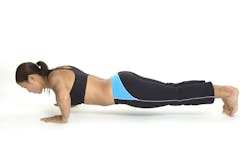5 myths of strength training for dental clinicians
When it comes to exercise, the amount of information available can be downright overwhelming. Whether in books, magazines, or on the web, there’s a time allotment preference and a fitness recommendation for every body type. Along with the recommendations on what we should be doing often come warnings for exercises that we should not be doing. Let me clear the air on some common myths about strength training for dental clinicians.
Myth 1: Don’t strengthen the chest
This is the most common and fundamentally incorrect piece of advice I hear. From a biomechanics perspective, the chest muscles are used for pushing resistance away from the body in tasks such as pushing a grocery cart, vacuuming, and pushing off the couch or out of the bathtub. They’re also partially responsible for supporting the shoulders.1 The argument is that due to the nature of the way we hold our shoulders and internally rotate them during clinical practice, the pectoralis muscles become shortened and tight. This part is correct, but the fog rolls in when it comes to what to do about it.
The solution is not just to stretch the chest and stop strengthening this important muscle—the one that can provide the means to remain independent and maintain posture and lung capacity and deep breathing—but instead to properly stretch the chest muscles while also building strength.2 To stretch the chest, bring the upper arm up so that the bicep is parallel with the ground and elbows are bent at a 90 degree angle. Using the forearm (including the elbow), lean face forward into a fixed object such as a door jam. To strengthen the chest, try negative pushups starting in plank position, then lower to the ground as slowly as possible.
You might also want to read
Chronic pain from muscular imbalances: How to exercise correctly to avoid pain
Exercises that might cause more harm than good for dental pros
Myth 2: Yoga is all you need
Yoga is great for dental clinicians, but it is not the end all, be all solution. Yoga can be gentle and relaxing or strenuous and difficult. I highly recommend that dental clinicians regularly practice yoga to get a full body stretch of all the muscles that we chronically contract for hours during practice. That said, yoga is a sequence of movements that releases contracted muscles through stretching, facilitates good breathing exercises, and aids in flexibility, balance, and mobility.3
What yoga doesn’t provide is impact for bone density, muscle building resistance, or cardiovascular exercise.4 Impact is what creates bone density through muscle fiber attachment and growth. Yoga generally lacks the resistance required to create muscle development until the practice becomes more advanced with significant weight bearing poses such as inversions. Don’t quit your yoga class! Stretching is a very important piece of the puzzle.
Myth 3: Running on the treadmill builds muscle
Not exactly. Running is great for cardiovascular health, endurance, mood enhancement, and bone density, but as much as it may render lean and dense leg muscles, it doesn’t do much else in the muscle department for posture or overall strength. The only caveat to this general rule is trail running. Trail runners are often forced to change cadence and pace on uneven or hilly terrain while dodging tree branches, roots, and rocks, which goes beyond simple use of the many stabilizer muscles of the core and goes further to challenge them. An avid trail runner who uses rugged trails can develop core muscle over time. Running or walking on an even, predictable treadmill or flat sidewalk is beneficial as cardiovascular activity but doesn’t substitute for strength training.
Myth 4: One workout a week is plenty
False! Frequency wins the fitness game. It’s better to do 10 minutes every day than 70 minutes once a week, but it’s also better to do one hour three or four days a week with 10 minutes of activity on the “off” days.5 This keeps the motor revving (metabolism ready) for activity daily so that the body doesn’t start from the bottom of the energy pile for each activity. Also noteworthy, “something is better than nothing” does apply here. But the fact remains that what you put in is what you get out. The more time spent working on strengthening the body, the more results can be expected.
Myth 5: Your body hurts so you shouldn’t exercise
This one is trickier but is still mostly false. If a specific part of the body is injured, that specific part shouldn’t be pushed for hypertrophy (muscle growth). It very likely may need modification or complete rest from exercise. This does not, however, mean that the rest of the body should be neglected. We have 639 skeletal muscles. The chances of all of them being injured are very low.
Keeping the entire musculoskeletal system actively working has benefits to cellular processes on a bigger scale. Maintaining mobility, and better sleep cycles that aid in recovery, are just a couple of examples. Additionally, if a biomechanical imbalance is the cause or contributing factor for the injury, specific strength training of the dysfunction may be the solution. There is almost always something that can be done to remain active, even during times of injury.
No matter what type of strength training a dental professional employs, there are a few ways to make it safe, effective, and practical in our busy lives.
- Get a game plan together. Preparation paves the way to action. Consistent action quantifies results. Schedule workouts at a time that is most convenient and likely to have fewer obstacles for completion.
- Pick a gym/facility/trainer/activity that is convenient. The fewer obstacles, the higher chance to be successful with the plan.
- Choose enjoyable workouts and cardiovascular activities. The chances of success for an activity that is miserable are slim to none. Do you hate running? That’s OK! Try bicycling, roller skating, aerobics, or something else enjoyable. Beware of the confusion between disliking the nature of an activity and disliking its difficulty. Example: I hate Zumba, not because it’s hard, but because it’s just not my thing. I choose exercises I prefer regardless of difficulty.
- Start where you’re at. This is the most important factor in a fitness journey. Strength training is a lifetime marathon, not a sprint. Allow for starting at the beginning, even if it’s the third or ninth time starting at the beginning. You won’t want to keep going if you overdo it and are extremely sore for two weeks after a workout. Check the ego at the door and start light to ensure proper form and safety before advancing.
References
1. Schütz P, Zimmer P, Zeidler F, Plüss M, Oberhofer K, List R, Lorenzetti SR. Chest exercises: movement and loading of shoulder, elbow and wrist joints. Sports (Basel). 2022;10(2):19. doi:10.3390/sports10020019
2. Ravindra A. 4 unexpected benefits of chest exercises. Northside Hospital. August 10, 2021. https://www.northside.com/about/news-center/article-details/4-unexpected-benefits-of-chest-exercises
3. Csala B, Szemerszky R, Körmendi J, Köteles F, Boros S. Is weekly frequency of yoga practice sufficient? Physiological effects of Hatha yoga among healthy novice women. Front Public Health. 2021;18;9:702793. doi:10.3389/fpubh.2021.702793
4. Kim S, Bemben MG, Knehans AW, Bemben DA. Effects of an 8-month Ashtanga-based yoga intervention on bone metabolism in middle-aged premenopausal women: a randomized controlled study. J Sports Sci Med. 2015;14(4):756-768.
5. Pescatello LS. ACSM's Guidelines for Exercise Testing and Prescription. Nineth edition. 2014.
About the Author

Katrina Klein, RDH, CEAS, CPT
Katrina Klein, RDH, CEAS, CPT, is a 15-year registered dental hygienist, national speaker, author, competitive bodybuilder, certified personal trainer, certified ergonomic assessment specialist, and biomechanics nerd. She’s the founder of ErgoFitLife, where she teaches that ergonomics and fitness are a lifestyle to prevent, reduce, and even eliminate workplace pain.

